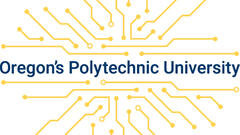
Two grants from the Oregon NASA Space Grant Consortium (OSGC) have allowed Oregon Institute of Technology (Oregon Tech) students to begin research and testing of a new Rover Submarine for planet exploration, and continue work on a RoboSub, which students will take to an autonomous underwater robotics student competition in August 2021.
The OSGC Affiliate Faculty Research Incubator Program awarded $14,000 to associate professor of Manufacturing, Mechanical Engineering, and Technology, Dongbin “Don” Lee, Ph.D., for his work with students on a Rover Sub, an amphibious submarine created to explore water and ice in the solar system. The group began designing the Rover Sub in the fall and is currently building a prototype to test in spring term. After June 2021, the team will be able to apply for additional research funding to continue their work.
The project is of public interest as the group looks for the existence of water or ice on any planet near Earth. They will then determine if that planet could be used to provide oxygen and hydrogen, specifically the moons of Earth, Mars, or Jupiter. Dr. Lee explains, “We are creating an amphibious robot that will be able to traverse a variety of ground conditions and is submersible, which will collect and record data about the environments and eventually, find possibilities so that human beings can inhabit such planets other than Earth.”
While attention is currently on the Mars 2020 Perseverance Rover landing on Mars, it is seeking signs of ancient life and collecting samples of rock and regolith (broken rock and soil) for possible return to Earth. “Currently, none of Mars Rover can, however, work if such vehicle encounters water or ice cap,” said Dr. Lee. “This is our motivation to create this Rover Sub. It will be able to move around muddy areas with wheels and explore under the water with thrusters similar to a submarine to find more evidence than can be found on the dried surface.”
Designing, building and testing a robot allows students to utilize a variety of STEM skills on an exciting, hands-on project that has the potential to be life-changing. Robotic technology is a frontrunner of STEM education that consists of multidisciplinary subjects based on science, math and engineering.
Sean Harrison, a senior in Mechanical Engineering and project lead said, “The Rover Sub project is an excellent opportunity to apply our coursework to the exciting world of engineering. It also provides an industry-like environment to practice teamwork, creativity and problem-solving skills.”
Dr. Lee has been advising mechanical and manufacturing student teams to build the hull and frame as senior capstone projects, and computer and software teams for their junior project. Included in the project scope is support for the Autonomous Unmanned Vehicle Systems and Intelligent Robotics (AUVSIR) team, which competes each year in a national student robotic competition with their RoboSub.
Moises Cobian, another Mechanical Engineering senior and project lead also shared, “Working on the Rover Sub as part of our senior project has been a crucial part of the learning process. The theory and hands-on applications taught at Oregon Tech have and continue to test our team during the completion of the RoboSub. Running into problems has been the best part. These are real-life situations that we will come across as engineers and with a solid team and engineering foundation with STEM disciplines; we are prepared for what’s next.”
The International RoboSub Competition requires students to design, fabricate, test and improve on an unmanned, untethered submarine system, and then to pass through a series of tasks, which mimic ongoing research in autonomous underwater vehicle systems widely performed in the Office of Naval Research, Boeing and Lockheed Martin research. The RoboSub competition requires entirely autonomous operation of the sub, meaning that once the sub is deployed from the dock, the submarine is required to recognize the environment and figure out how to navigate the tasks without human input. Oregon Tech has participated in the competition since 2016, previously being awarded "Most Innovation in a Vehicle Design" in 2018.
Cesar Robles serves as team lead for AUVSIR and is a senior in Mechanical Engineering. “The motivation of this project is to gain knowledge of the engineering process, build communication skills, and improve upon current design,” he wrote. “Along with improving our understanding and application of our education in real-life scenarios, our goal is also to advance technology and build relationships with teams and companies.”
Working on projects like the AUVSIR RoboSub allows team members to work in an industry-like environment where they must obtain knowledge and experience outside of their respective fields of education. In addition to a professional environment, RoboSub offers hands-on application of necessary subjects including fluid dynamics, 3D model design, machining and manufacture, and software design.
Oregon Tech’s AUVSI club president Theodor Giles is a sophomore in Environmental Sciences and shared, “Right now, we have a full team of Mechanical Engineering seniors that are working on our 'RoboSub V2'. Each person is dedicated to a part of the Sub, such as a robotic arm, a Wall-E inspired vision system, an autonomous torpedo (completely harmless in these first steps), as well as other smaller but still essential modules. We are planning to take both software, hardware components, and mechanical practices from the RoboSub and incorporate it into our bigger ideas for the Rover Sub."
The RoboSub team consists of Mechanical Engineering students, Moises Cobian (senior), Xuanhe Du (senior), Mauricio Huntoon DeRoche (sophomore), Jake Mitchell (senior), Quinton Orr (freshman), Christopher Ramirez (senior), and Cesar Robles (senior); Mechanical Engineering Technology student Caleb Nagel (senior); Electrical Engineering student Donavin Brown (senior); Environmental Sciences student Theodor Giles (sophomore); Software Engineering Technology students JJ In (sophomore) and Jay Sucharitakul (senior); and Embedded Systems Engineering Technology student Robert Rowland (sophomore). Sean Harrison (senior, Mechanical Engineering) is dedicated to the conceptual design of the Rover Sub.
Funding from Oregon Tech’s Resource Budget Commission and an OSGC Undergraduate Team Experience Award help support the RoboSub. The Undergraduate Team Experience Award Program provides funding to undergraduate team projects that are student-led, hands-on research projects that provide a unique student team experience, particularly those leading to participation in STEM-based student competitions.
To learn more visit the OTUS team website at https://sites.google.com/view/otusrobosub or http://auvsioit.wixsite.com/otus.
###








